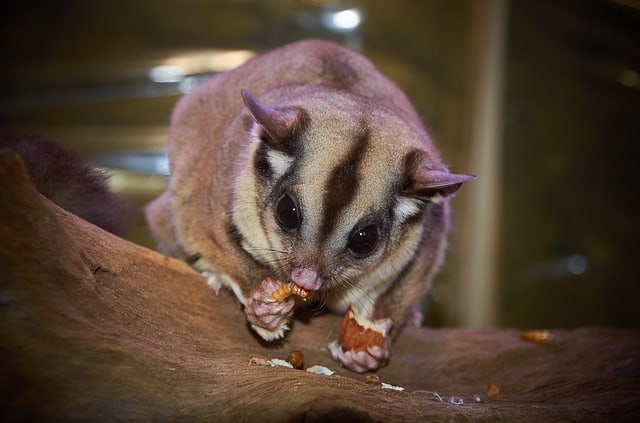
The sugar glider is also known as the flying squirrel : let’s get to know its physical and temperamental characteristics and all you need to know to be able to breed it at home.
The Sugar Glider ( Petaurus breviceps , from the Latin “acrobat with a short head”) belongs to the Petauridae family and is a small marsupial .
In recent years it has become increasingly popular as a pet, even if it is not really that simple to raise it at home. Falling in love with it is easy, taking care of it correctly, as it is necessary, is not easy and requires time, space and care of a certain type.
Sugar glider: physical characteristics
This marsupial is up to 30cm long , including the tail which can be as long as the whole body. The latter is very important because it is an excellent tool to collect food or stand on trees.
Not surprisingly, it is called a flying squirrel, as it flies in all respects! These glides are due to the presence of a membrane called patagio . The patagio crosses the whole body in the lower part, extending from the hind legs to the front ones.
His flight is the result of a mathematical calculation where he takes into account many factors to reach his destination. They manage to jump even up to 60-70 meters in height.
The glider weighs about 115 grams for females and 140 grams for males . Furthermore, males are also distinguished by having a small, hairless area on the head.
The coat is gray and characterized by darker stripes. It is thick but short. The belly is completely white and the females, just like kangaroos, have a pouch to accommodate the cubs.
The head has a triangular shape, with large eyes and very small ears that are able to detect the presence of the prey in the dark. The flying squirrel lives for about ten years . The longest-lived specimens reach up to the age of 14.
Being native to the rainforest and coastal areas of Australia and New Guinea , it should be considered to all intents and purposes as an exotic animal.
Sugar glider: Nature and behavior
In spite of what one might imagine, the sugar glider looks like an animal with a tendency to socialize . He always wants company , so it is often suggested to buy them in pairs .
He also loves being in the good graces of his master and in some cases it has been seen as being able to show affection by flying towards him when he returns home.
However it is not suitable for children, as it cannot be treated like a cuddly puppet, it is particularly delicate. Before allowing yourself to be caressed (temptation which is difficult to resist), you must have gained his trust, which requires a little patience and time. Do not forget that the sugar glider has sharp nails and teeth and, even if it is not an aggressive animal, it will bite the moment it feels threatened or frightened.
Sugar Glider: price and home breeding
The cost of this pet is around $200 to $500. Since it must be purchased in pairs, you have to consider a double expense. If you don’t want to find yourself a real glider farm, avoid buying male and female.
Before venturing into this choice, take into consideration all its needs, first of all the fact that, left free, it flies from one corner to another . It may not be pleasant for some to find a flying squirrel jumping from room to room.
Furthermore, you should know that it also emits its own characteristic sound and that being a nocturnal animal it could make some noise while you sleep.
Where to raise Sugar Glider
You will need to have an aviary large enough to facilitate movement. Keeping him in a cage would be a real torture for him, so if you don’t have space, avoid adopting him .
Also, bear in mind that males have a heavier, more pungent odor . The place must therefore also be evaluated well.
Inside this aviary (which must be at least 2 meters high), you will place everything you need to eat and drink, including small games. You have to place it in a dark corner and make sure it is not exposed to thermal changes. Try to recreate its natural habitat by inserting branches from which to jump.
What Food does a Sugar Glider eat?
You will have to prepare food every night, as it is a nocturnal animal . Eat mostly vegetables, fruits and insects. Obviously to compensate for the lack of protein you will have to focus on crickets, locusts and so on, which you will surely find in pet shops.
You will need to add a calcium supplement to your diet every week , as it needs it for your bones. Unfortunately, there is still no single product on the market that is able to provide all the nutritional elements to the glider.
Consequently, you will have to arm yourself with patience and try to balance his diet, avoiding that he accumulates weight .
For any doubt and for periodic visits, it is always good to contact veterinarians who are experts in exotic animals.






